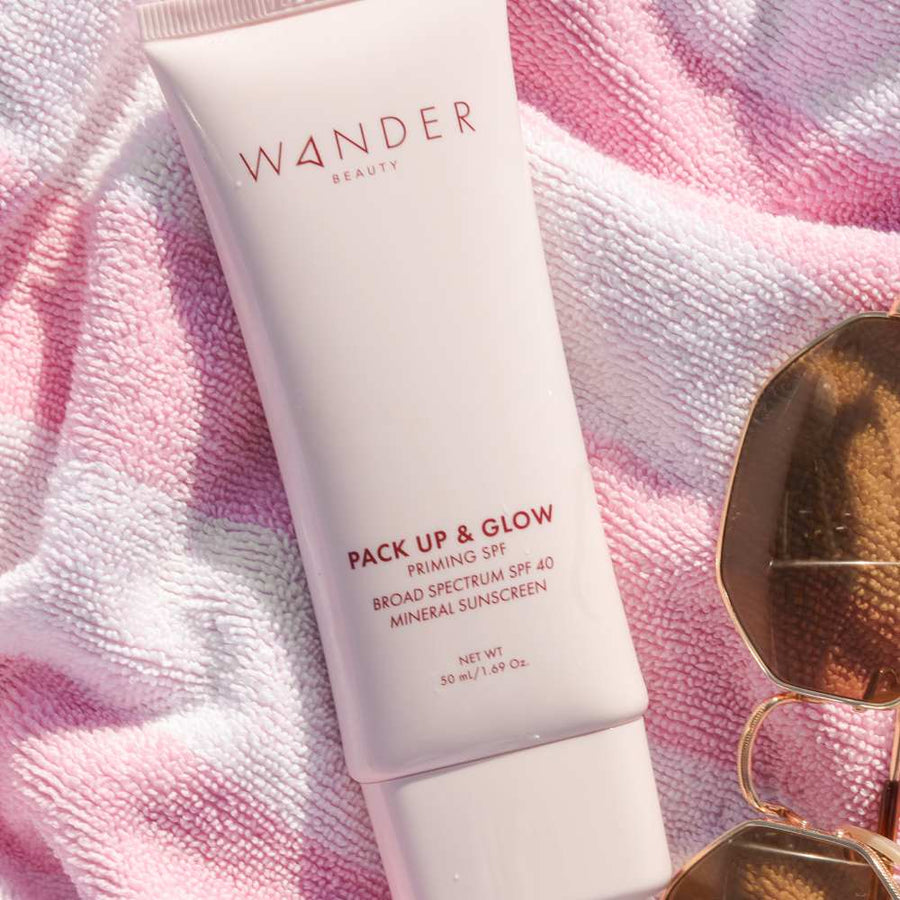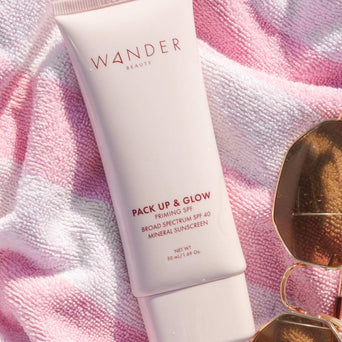What's the Difference between Mineral and Chemical Sunscreen?
By Wander Beauty | Jul 25, 2022
We all know the importance of wearing sunscreen to keep our skin looking healthy and protect it from the harmful rays of the sun. But with so many options on the market, things can get a bit confusing.
For many of us, the extent of what we look for begins and ends with a decent SPF. Others may favor products from trusted brands without reading the label, or go for the promise of a sunkissed glow that’s presented on the bottle.
Like other cosmetic products, not all sunscreens are created equal. There are two main types of sunscreen – chemical and mineral. As the name suggests, the key difference lies in the ingredients, and also in the way in which each type protects your skin. Chemical sunscreens absorb and convert sun rays, whereas mineral sunscreens create a protective layer on the skin that blocks and reflects sun rays.
Each of these types has both pros and cons, so before deciding which is the best sunscreen for your skin type, let’s take a deeper look at how they compare.
Spotlight on chemical sunscreens
Chemical sunscreens utilize chemical filters such as oxybenzone, avobenzone, octinoxate, and octisalate to help protect the skin from damaging ultraviolet rays. These ingredients act as a sponge, absorbing radiation and turning it into heat, which is released through the skin.
The pros
Chemical formulas tend to be lighter and more sheer, making them widely favored by consumers. They’re easy to apply and are ideal for all skin tones as they don’t contain the thick, chalky finish synonymous with mineral sunscreens.
The cons
Studies have shown that more than 96 percent of sunscreens sold in the US contain chemical SPF ingredients rather than mineral-based ingredients, making them a highly popular choice. Unfortunately, this doesn’t necessarily mean they’re the best choice. Here’s why.
Despite their appealing texture and consistency, chemical sunscreens have been found to be irritating to those with sensitive or acne-prone skin. These formulas are more likely to cause allergic reactions, and often worsen melasma and rosacea, making them less than ideal for a wide range of people. Furthermore, a review published in 2019 in the Journal of the American Academy of Dermatology found common ingredients in chemical sunscreen such as oxybenzone may damage coral reefs, and urged people to avoid using these sunscreens when swimming in the ocean.
Spotlight on mineral sunscreens
While chemical sunscreens use chemicals to filter out damaging UV rays, mineral-based sunscreens create a thin layer on the skin that (literally) physically blocks ultraviolet radiation, reflecting it away from the skin. For this reason, mineral sunscreens are also called “physical sunscreens,” with active ingredients such as titanium dioxide and zinc oxide making them a more favorable choice among those who normally prefer natural skincare. The National Library of Medicine published the article “Assessing the current market of sunscreen” which shared that only around 3.4 percent of sunscreens in the US are mineral-based, but this proportion is sure to rise as people become more health- and environmentally conscious.
The pros
Now that you know what mineral sunscreen is, what are the benefits of using it? In general, mineral sunscreens are considered the safer option for those concerned about long-term exposure to chemical ingredients. They’re also the best choice for those with allergies, sensitivities and skin conditions, as they don’t contain harsh, irritating chemicals. These formulas protect the skin from the moment you apply them, unlike chemical formulas, which can take 15 to 30 minutes to be absorbed into the skin, according to New York based dermatologist, Dr. Dendy Engelman, who shared her thoughts in an article titled “Every Little Thing You Need to Know About How to Apply Sunscreen Correctly” published on Good Housekeeping. They can also be applied either before or after makeup, making them ideal for reapplications throughout the day.
The cons
While it seems obvious that mineral sunscreen is the safest, healthiest option, why is it that most people still opt for its chemical counterpart? Generally, mineral formulas are thicker and harder to apply. People often complain that they leave a white, chalky appearance, especially on darker skin tones.
While this may have been the case a long time ago, mineral-based skin protection formulas have undergone a massive transformation, especially in recent years. Now used in combination with a range of natural ingredients, today, you’ll be able to find a number of lightweight options that are just as effective as chemical formulas without any of the nasties.
Our daily go-to
Ultimately, the best face sunscreen is the one you’ll want to wear every day. When choosing one, consider:
- What’s best for your skin type
- Ingredients (some may cause allergies or sensitivities)
- Sun protection factor (SPF), which should be at least 30
Because we care about the health of your skin and of the planet, Wander Beauty has created a mineral-based formula that protects your skin, prevents moisture loss, perfects your glow and acts as a priming base for makeup application. Our Pack Up & Glow Priming Mineral is an easy-to-apply, lightweight formula with SPF 40 that can be used on all skin tones and types. Expertly crafted to contain an antioxidant complex, plant-derived hyaluronic acid and bisabolol to soothe sensitive and irritated skin, our formula is never greasy, sticky or heavy. It’s perfect for use on its own or in combination with our other skincare tools.<product>1</product>
Give yourself the best skincare routine
Sunscreen is essential come rain or shine – whether you’re bathing on the beaches of Miami or skiing the slopes of Alaska, sunscreen should form part of your daily skincare routine. For best results, apply your chosen sunscreen after washing and moisturizing your face, and before applying makeup. Reapply every two hours for perfectly protected skin all year round.
What's the Difference between Mineral and Chemical Sunscreen?

We all know the importance of wearing sunscreen to keep our skin looking healthy and protect it from the harmful rays of the sun. But with so many options on the market, things can get a bit confusing.
For many of us, the extent of what we look for begins and ends with a decent SPF. Others may favor products from trusted brands without reading the label, or go for the promise of a sunkissed glow that’s presented on the bottle.
Like other cosmetic products, not all sunscreens are created equal. There are two main types of sunscreen – chemical and mineral. As the name suggests, the key difference lies in the ingredients, and also in the way in which each type protects your skin. Chemical sunscreens absorb and convert sun rays, whereas mineral sunscreens create a protective layer on the skin that blocks and reflects sun rays.
Each of these types has both pros and cons, so before deciding which is the best sunscreen for your skin type, let’s take a deeper look at how they compare.
Spotlight on chemical sunscreens
Chemical sunscreens utilize chemical filters such as oxybenzone, avobenzone, octinoxate, and octisalate to help protect the skin from damaging ultraviolet rays. These ingredients act as a sponge, absorbing radiation and turning it into heat, which is released through the skin.
The pros
Chemical formulas tend to be lighter and more sheer, making them widely favored by consumers. They’re easy to apply and are ideal for all skin tones as they don’t contain the thick, chalky finish synonymous with mineral sunscreens.
The cons
Studies have shown that more than 96 percent of sunscreens sold in the US contain chemical SPF ingredients rather than mineral-based ingredients, making them a highly popular choice. Unfortunately, this doesn’t necessarily mean they’re the best choice. Here’s why.
Despite their appealing texture and consistency, chemical sunscreens have been found to be irritating to those with sensitive or acne-prone skin. These formulas are more likely to cause allergic reactions, and often worsen melasma and rosacea, making them less than ideal for a wide range of people. Furthermore, a review published in 2019 in the Journal of the American Academy of Dermatology found common ingredients in chemical sunscreen such as oxybenzone may damage coral reefs, and urged people to avoid using these sunscreens when swimming in the ocean.
Spotlight on mineral sunscreens
While chemical sunscreens use chemicals to filter out damaging UV rays, mineral-based sunscreens create a thin layer on the skin that (literally) physically blocks ultraviolet radiation, reflecting it away from the skin. For this reason, mineral sunscreens are also called “physical sunscreens,” with active ingredients such as titanium dioxide and zinc oxide making them a more favorable choice among those who normally prefer natural skincare. The National Library of Medicine published the article “Assessing the current market of sunscreen” which shared that only around 3.4 percent of sunscreens in the US are mineral-based, but this proportion is sure to rise as people become more health- and environmentally conscious.
The pros
Now that you know what mineral sunscreen is, what are the benefits of using it? In general, mineral sunscreens are considered the safer option for those concerned about long-term exposure to chemical ingredients. They’re also the best choice for those with allergies, sensitivities and skin conditions, as they don’t contain harsh, irritating chemicals. These formulas protect the skin from the moment you apply them, unlike chemical formulas, which can take 15 to 30 minutes to be absorbed into the skin, according to New York based dermatologist, Dr. Dendy Engelman, who shared her thoughts in an article titled “Every Little Thing You Need to Know About How to Apply Sunscreen Correctly” published on Good Housekeeping. They can also be applied either before or after makeup, making them ideal for reapplications throughout the day.
The cons
While it seems obvious that mineral sunscreen is the safest, healthiest option, why is it that most people still opt for its chemical counterpart? Generally, mineral formulas are thicker and harder to apply. People often complain that they leave a white, chalky appearance, especially on darker skin tones.
While this may have been the case a long time ago, mineral-based skin protection formulas have undergone a massive transformation, especially in recent years. Now used in combination with a range of natural ingredients, today, you’ll be able to find a number of lightweight options that are just as effective as chemical formulas without any of the nasties.
Our daily go-to
Ultimately, the best face sunscreen is the one you’ll want to wear every day. When choosing one, consider:
- What’s best for your skin type
- Ingredients (some may cause allergies or sensitivities)
- Sun protection factor (SPF), which should be at least 30
Because we care about the health of your skin and of the planet, Wander Beauty has created a mineral-based formula that protects your skin, prevents moisture loss, perfects your glow and acts as a priming base for makeup application. Our Pack Up & Glow Priming Mineral is an easy-to-apply, lightweight formula with SPF 40 that can be used on all skin tones and types. Expertly crafted to contain an antioxidant complex, plant-derived hyaluronic acid and bisabolol to soothe sensitive and irritated skin, our formula is never greasy, sticky or heavy. It’s perfect for use on its own or in combination with our other skincare tools.<product>1</product>
Give yourself the best skincare routine
Sunscreen is essential come rain or shine – whether you’re bathing on the beaches of Miami or skiing the slopes of Alaska, sunscreen should form part of your daily skincare routine. For best results, apply your chosen sunscreen after washing and moisturizing your face, and before applying makeup. Reapply every two hours for perfectly protected skin all year round.


